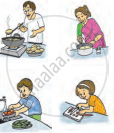Advertisements
Advertisements
Question
Griffin failed not only as a son and a scientist, but also as a human being. Comment. (The Invisible Man)
Solution
Griffin was a very intelligent and hard working scientist who put in all heart and soul into his research. He worked with a focused mind and stopped at nothing short in pursuit of his scientific goal to achieve invisibility.Unfortunately his passion warped into an obsession and he stooped to pits of depravity.Griffin was a student of medicine at the University College where he won a medal for excellence in chemistry.He was almost an albino, six feet high and broad with a pink and white face and red eyes. Hiskeen interest in light drew him to physics. Fascinated by optical density, he moved to Chesilstowe after leaving London. At that time he was twenty two years old and full of enthusiasm. He worked as a lecturer in a provincial college with his superiors and his peers, he worked stealthily so that he wouldn’t have to share the credit of his work with anybody. He cut himself off from normal social life and withdrew into the dark interiors of selfishness. His poverty drove him to the extent of robbing his own father, creating such a situation that that the old man had to commit suicide in order to escape humiliation. The lack of remorse at the death of his father was a firm point when this otherwise brilliant scientist turned into a self-centred, selfish and callous man. Throwing to winds all ethics and morality, Griffin grew short tempered, intolerant and vindictive. He finally succeeded in his ambition but the unforeseen problems that were generated because of his invisible condition compelled him to move to Iping, a remote village.Embittered by his pseudo success Griffin continued to fall morally. He made life miserable forthe people of Iping, especially that of the Hall couple. He resorted to theft robbery, and terror to proclaim a false sense of superiority. The absence of humane sensitivity in Griffin became clear when he forced a vulnerable Marvel to be his accomplice. The brutal manner in which he killed Wicksteed and chased Kemp to avenge treachery marked the eventual destruction of goodness, mercy and kindness that are trademark of an intelligent scientist.Therefore Griffin’s character comes out more as a wicked, crazy and heinous criminal than a responsible scientist.
APPEARS IN
RELATED QUESTIONS
Answer the following question in 120-150 words :
Nancy Lammeter is a typical country girl. Comment.
Answer any four of the following in 30 – 40 words each:
(a) How did his experience at the YMCA swimming pool affect Douglas?
(b) What hospitality did the peddler receive from the crofter?
(c) Aunt Jennifer;s efforts to get rid of her fear proved to be futile. Comment.
(d) What does Stephen Spender want to be done for the children of the school in a slum?
(e) What kind of life was enjoyed by crown prince Jung Bahadur till he reached the age of twenty?
(f) Where, when and how did Dr. Sadao meet Hana?
How does the poem capture the elusive nature of the peacock?
The following two common words are used in a different sense in the poem. Guess what they mean
| bark | compass |
What, according to Ruskin, are the limitations of the good book of the hour?
Discuss the following in pairs or in small groups.
“Discipline and a questioning spirit can coexist in an individual.”
Read the following statement and mark those that apply to you.
I have a large group of friends but no best buddy.
Give a brief account of the interaction between Grandpa and Jo.
Discuss in groups and share your answer with the class.
Can you name the famous musician in Emperor Akbar’s court, who could perform miracles, when he sang different Ragas?
Now write what you observe in the following two pictures.


Using a dictionary/internet note down the main difference between our strengths and our achievements.
Read other poems by Leigh Hunt, especially 'Abou Ben Adhem'.
Compare the messages in that poem with those in 'The Plate of Gold'. What do you observe?
What question did Shalihotra ask Sushruta?
Visit a library:
Find and read stories and poems written by Edith Nesbit.
Read the passage. Underline the new words. Guess their meaning from the context. Verify it from a good dictionary.
There were no human settlements on the moon.
‘Unke, Munke, Timpetoo,
I wish, my wish is coming true.’
Try to compose two other funny magical chants that have rhyming lines.
Find out how the following game is played.
Badminton
Tell any one of the stories orally imagining you are Gulliver.
Why was Sir Francis angry?
Read the incidents. Work in small groups to role play the situations in which they showed their presence of mind. Each group should perform the skit for the rest of the class. Share similar situations in the class.
Write the story in your own words
Fill in the blanks to complete the summary.
Ever since their introduction, ______, and their unique rhythms have ______ poets. In this poem the poet shares his experience ______ with us. He presents natural scenes seen from ______ a railway carriage. The ______ is regular and steady but ______ from the window of the train is constantly changing. The poem’s rhythm and phrases bring ______ of a railway journey. The poet looks out of the window at the ______ images outside. Every line we see here is a quick account of something seen for ______. The line that best sums up is the final one: "Each a glimpse and gone forever!"
The battle of Nauranang lasted for three days.
Jaswant decided to stay in his post.
Why was Chris worried?
What did Nasruddin boast about?
Who was burning with curiosity?
What does the earth do when the day is over?
Read the passage and write a summary of it. Suggest a suitable title to the summary
|
A sparrow is a small bird which is found throughout the world. There are many different species of sparrows. Sparrows are only about four to six inches in length. Many people appreciate their beautiful songs. Sparrows prefer to build their nests in low places-usually on the ground clumps of grass low trees and low bushes. In cities, they build their nests in building nooks or holes. They rarely build their nests in high places. They build their nests out of twigs grasses and plant fibers. Their nests are usually small and well-built structures. Female sparrows lay four to six eggs at a time. The eggs are white with reddish-brown spots. They hatch within eleven to fourteen days. Both the male and female parents care for the young. Insects are fed to the young after hatching. The large feet of the sparrows are used for scratching seeds. Adult sparrows mainly eat seeds. Sparrows can be found almost everywhere where there are humans. Many people throughout the world enjoy these delightful birds. The sparrows are some of the few birds that engage in dust bathing. Sparrows will first scratch a hole in the ground with their feet then lie in it and fling dirt or sand over their bodies with flicks of their wings. They will also bathe in water or in dry or melting snow. Water bathing is similar to dust bathing with the sparrow standing in shallow water and flicking water over its back with its wings also ducking its head under the water. Both activities are social with up to a hundred birds participating at once and are followed by preening and sometimes group singing. |
